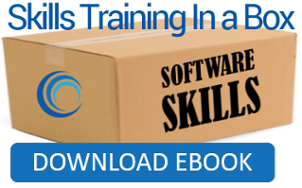 Managers pull double duty. Not only are you responsible for your team’s output, but you lead its growth as well. Some freshly promoted managers may be unfamiliar with the fundamentals of employee training and development. After all, you probably didn’t get your degree in andragogy (more on that in a bit).
Managers pull double duty. Not only are you responsible for your team’s output, but you lead its growth as well. Some freshly promoted managers may be unfamiliar with the fundamentals of employee training and development. After all, you probably didn’t get your degree in andragogy (more on that in a bit).
Train & develop your employees like a pro
If you’re new to training and development, wondering "What is training and development?" consider this post your playbook. We’ll walk you through the essentials from what motivates adult learners to ongoing strategies for employee development. Grab a pencil. School’s now in session!
What drives us to learn? Ask Malcolm Knowles
As we get older, we learn how to learn differently. Adults have a drastically different set of priorities and internal drivers than children that change how we acquire new knowledge or skills. Malcolm Knowles understood this, too. His research and theories about adult learning paved the way for new model for adult education he called andragogy.
Knowles’ model relies on six assumptions about adult learning worth considering when setting up training for your team:
- Need to know - Adults are more motivated when they understand why they should learn something.
- Foundation - Adults have a deep well of experience that provide an important foundation for learning. Even mistakes are useful building blocks.
- Readiness - Adults are more motivated to learn subjects that have immediate relevance.
- Orientation to learning - Adult motivation is often more problem-centered, as opposed to subject-centered.
- Motivation - Internal motives are more compelling than external for adult learning.
- Self-concept - Adults need to be self-directed in their learning paths.
Keep these assumptions handy. They could help you fine tune the training you deliver to make it feel more relevant, or help isolate why a particular approach isn’t connecting.
You can learn more here about how Malcolm Knowles’ pioneering model, as well as how KnowledgeWave relies on it for much of our curriculum.
We all learn differently
Finish this sentence, “I learn best when I can ______.” Do you prefer reading to learn? Maybe you’re a hands-on kind of person. That preference is your individual learning type. There are several approaches that attempt to explain how we prefer to learn. For simplicity’s sake, let’s look at the well-known VARK model - which uses four classifications of learning styles.
- Visual learners learn best when information is presented in the form of various labeled maps, charts, diagrams, hierarchies, and symbols, representing visually what could be described in words.
- Auditory learners prefer information that is heard or spoken by themselves or others; this includes lectures, group discussions, digital presentations, and talking things through.
- Reading/writing learners like to gather their information through good old-fashioned words and text-based input. They do well with reading and writing in all its forms, but especially manuals, reports, essays, and written assignments.
- Kinesthetic learners glean information from direct experience and applied practice. This might involve demonstrations, simulations, case studies, and videos containing “real” examples. Kinesthetic or tactile learners value concrete understanding and do not benefit as much from the experiences of others.
Theory is one thing. Applying it to your team is an entirely different challenge. Here are some handy tips for reaching the whole team, regardless of their varying learning styles:
- Make sure that your training includes an opportunity to tie the learning objectives back to business needs and job responsibilities
- Provide guided practice with feedback and room for mistakes.
- Consider blended learning, a speciality of KnowledgeWave, using technology and online training combined with more traditional classroom training methods.
- Make sure there is room in your training schedule for slower learners before moving on -not everyone absorbs information at the same pace.
- Provide an outline or any other type of "advanced organizer”.
- Build practice sessions and group activities throughout the training, such as role play, brainstorms, and small group discussions.
- Ensure your trainees use the skills within 30 days of the training.
Identify your training needs
Professional trainers and educators could (and often do) spend months performing thorough training needs assessments. We know you don’t have that kind of time, so here’s a simplified approach to discovering what training you need now and who needs it:
1) Organizational Analysis - Work with leadership to articulate the training priorities and ensure that there is clear alignment between the training goals an business objects. Write down the desired business outcomes.
2) Task Analysis - Your goal here is to produce a list of tasks required to perform a job, then for each taks, identify what skills/competencies are required.
3) Person Analysis - Identify who has mastered the skills/competencies, and who still needs to learn. This helps you target your efforts to the widest gaps.
Get blended for better results
Determining which training method would work best for your team is difficult to boil down in a single post. There are many influences and drivers to factor - as well as methods by which training can be delivered. Your best bet is to cast a wide net to reach as many learner styles as possible at once. That’s where blended learning can help. It’s the approach we use at KnowledgeWave, and revered by managers and organizations for its: flexibility, cost effectiveness, personalization and capacity to reach all learner types.
Training is only the beginning
While you’re there, you’ll notice that we named our site the KnowledgeWave Learning Site. Importantly, we focus our clients around the concept of learning and not training. Training is usually thought of as a finite period of time or for a specific purpose which then ends. Learning is a continuous process that does not end. For example, while an Office 365 migration brings with it certain things that should be learned/trained at the outset, there is way too much information to absorb through a short training session. A continuous learning message and strategy is what makes our offering so powerful.
Your overall training plan should include a development strategy so, as your team gains new skills and abilities, you can nurture them for the benefit of the employee, your team’s combined output, and the greater good of the organization. To help you think long-term about your own development strategy, try incorporating some of these approaches from Jerome Ternyck of SmartRecruiters.
Stretch assignments and projects - Think about what special assignments might exist in the coming months and who on your team would benefit from serving on a cross-functional team while developing additional skills
Job enrichment - These opportunities typically exist internally that will benefit an employee's current role, while creating additional ways to develop. Examples could include presentations at team meetings, joining a diversity committee or volunteering.
Mentoring or coaching - Whether or not your company has a formal mentoring program, start small. Mentoring and coaching provides demonstrated benefits around quality of work, problem solving and communication skills.
Job shadowing. Job shadowing can be a great way for your employees to learn critical elements of other jobs, while further developing in their own. It is also a great way for employees to more formally explore potential career opportunities internally, yet outside of their current job.
Job Rotation. Providing an opportunity for your team to move and rotate through one or more positions is another great strategy in employee development. Rotations can last for days, months, or even a year or two.
Lateral move. Typically with a lateral move an employee takes on a different position with the same salary grade and similar level of responsibilities. In addition to retaining employees longer, the real benefit of a lateral move provides new challenges and skill development.
Promotions. When executed with the right plan, promoting your employees into a new position is another way to reward great performance, develop skills and increase motivations.
Okay, pencils down! When you’re mindful of what motivates your team members to learn, how they learn, and what they need, you’ll be well on your way to getting the best out of your workers. But don’t forget, training is just a component of a larger strategy. With time and planning, you can develop them into superstars other departments will envy.








